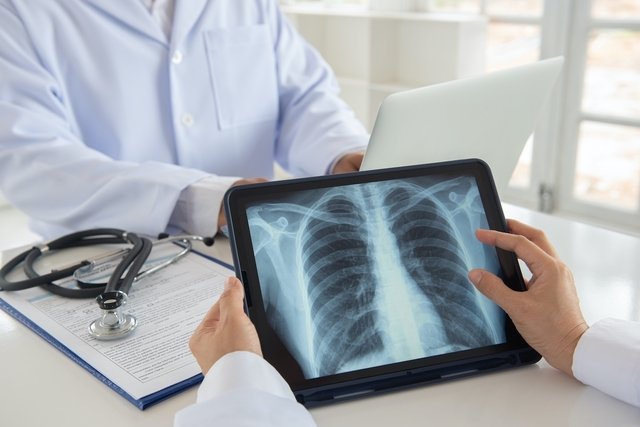Bilateral pneumonia is an infection that affects both lungs and is considered more serious than common pneumonia, as it causes inflammation in the lung alveoli, which can fill with fluid or pus, reducing respiratory capacity. As a consequence of this, there is a decrease in the amount of oxygen circulating in the body, including in the brain, which can lead to a change in the person’s level of consciousness.
This type of pneumonia can be caused by viruses, bacteria or fungi, and is more common in people with a weakened immune system, such as babies, older people or those who have chronic diseases that can interfere with the functioning of the immune system.
The treatment of bilateral pneumonia is normally carried out in a hospital environment so that the person is monitored and receives oxygen, making it possible to reduce the risk of complications such as generalized infection, respiratory arrest or pleural effusion, for example.

Symptoms of bilateral pneumonia
The symptoms of bilateral pneumonia are:
- Fever greater than 38ºC;
- Cough with a lot of phlegm;
- Great difficulty breathing;
- Increased respiratory rate;
- Easy and intense tiredness;
- Bluish or purplish coloration of nails or lips;
- Chest pain when breathing or coughing;
- Nausea and vomiting;
- Mental confusion, especially in the elderly.
These symptoms are mainly related to the person’s respiratory capacity, which can be severely compromised, as both lungs are affected.
When a person presents other symptoms related to a lack of oxygen, such as slightly bluish lips or altered levels of consciousness, it is very important to inform the pulmonologist so that treatment can be carried out as quickly as possible, especially with the use of oxygen masks. . Know how to recognize the symptoms of pneumonia.
How to confirm the diagnosis
The diagnosis of bilateral pneumonia is made by the general practitioner or pulmonologist, through the evaluation of symptoms, health history and physical examination by asking the person to breathe in and out, while listening to the lungs with a stethoscope, to check for noises during the lungs. breathing.
The doctor must also perform an oximetry test, placing a device on one of the fingers of the hand to measure the amount of oxygen in the blood.
Additionally, to confirm that pneumonia has affected both lungs, the doctor must order a chest X-ray or CT scan.
Other tests that may be ordered by the doctor are blood tests, sputum testing, bronchoscopy and pleural fluid culture, to identify the infection and which microorganism is causing bilateral pneumonia.
Possible causes
Bilateral pneumonia is caused by inflammation in both lungs due to infection by viruses, bacteria or fungi.
Some factors increase the risk of developing pneumonia in both lungs, such as:
- Age, being more common in children under 2 years of age and the elderly;
- Malnutrition;
- Smoking or passive smoking;
- Chronic illnesses such as diabetes, anemia or heart disease;
- Chronic obstructive pulmonary disease (COPD);
- Cystic fibrosis;
- Asma;
- Neurological conditions that cause difficulty swallowing, such as stroke;
- Excessive consumption of alcoholic beverages.
These factors can weaken the immune system, which makes it difficult for the body’s defense system to fight microorganisms. See how you get pneumonia and how to prevent it.
How the treatment is carried out
Treatment for bilateral pneumonia must be guided by a pulmonologist, being defined through a system that classifies patients according to the symptoms described and test results. Patients classified as low risk are normally treated at home with the use of antibiotics, such as Levofloxacin or Clarithromycin, for example, with the duration of use defined by the doctor.
Furthermore, it is important that the person remains at rest during treatment, drinks plenty of fluids, nebulizes with drinking water and avoids public or heavily polluted spaces, in addition to using protective masks whenever necessary.
In the case of patients classified as serious, especially when the patient is elderly or has impaired renal function, blood pressure and great difficulty in carrying out gas exchange, treatment is carried out in a hospital environment. Treatment in the hospital normally lasts between 1 and 2 weeks, which may vary according to the patient’s response to therapy, and is normally carried out by administering oxygen and antibiotics. After discharge, antibiotic treatment should be continued for at least 1 week or as recommended by the pulmonologist.
Bibliography
- GALVÁN, JM; et al. Review of Non-Bacterial Infections in Respiratory Medicine: Viral Pneumonia. Arch Bronconeumol. 51. 11; 590-7, 2015
- HOOVEN, T. A.; POLIN, R. A. Pneumonia. Semin Fetal Neonatal Med. 22. 4; 206-213, 2017

Sign up for our newsletter and stay up to date with exclusive news
that can transform your routine!
Warning: Undefined array key "title" in /home/storelat/public_html/wp-content/plugins/link-whisper-premium/templates/frontend/related-posts.php on line 12
Warning: Undefined array key "title_tag" in /home/storelat/public_html/wp-content/plugins/link-whisper-premium/templates/frontend/related-posts.php on line 13




